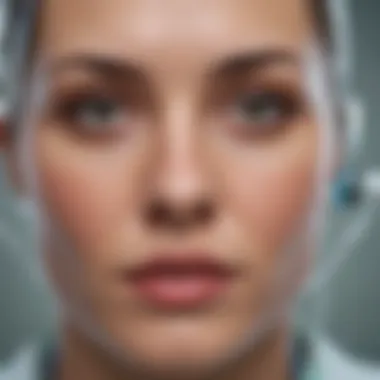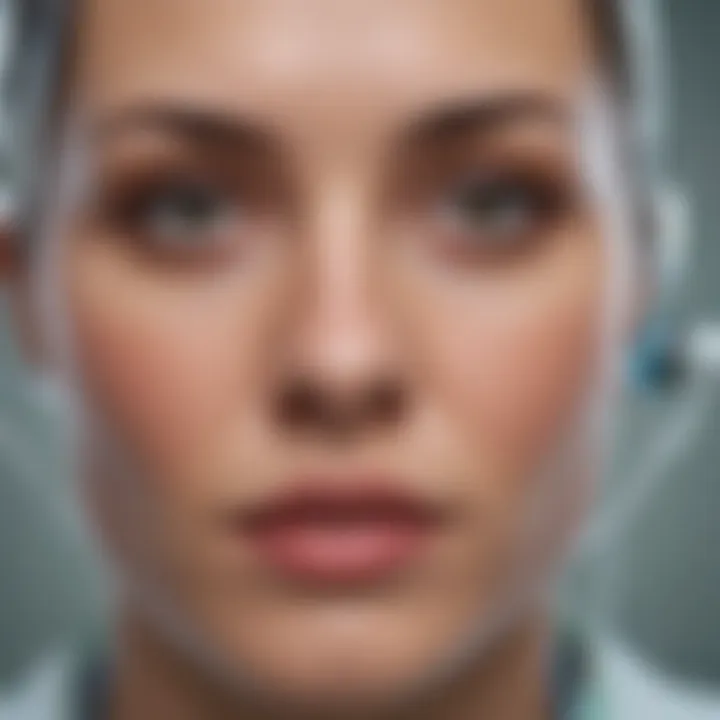Automated Anesthesia: Transforming Patient Care


Intro
Automated anesthesia is a rapidly advancing field that is changing how anesthesia is administered in surgical and procedural settings. This technological evolution hinges on the integration of sophisticated software and hardware systems that enhance the safety and efficiency of patient care. With its ability to optimize drug delivery and monitor patient responses in real time, automated anesthesia promises to improve outcomes and reduce human error in the practice of anesthesiology.
This article will delve into various aspects of automated anesthesia, exploring its development, implementation, and implications in healthcare. By shedding light on the technological advancements and ethical considerations, it aims to provide a clear perspective on the role of automation in the future of patient care.
Preface to Automated Anesthesia
Automated anesthesia represents a significant step forward in the field of anesthesiology, merging technology with medical practice. It aims to enhance precision in drug administration, streamline workflow, and ultimately improve patient outcomes. As surgery and other medical interventions evolve, the need for efficiency, consistency, and safety in anesthesia delivery becomes paramount. This article delves into the nuances of automated anesthesia, elucidating its role in modern healthcare.
Defining Automated Anesthesia
Automated anesthesia can be defined as the use of technology to deliver anesthetic agents with minimal human intervention. This involves the integration of computer algorithms and sophisticated monitoring systems to tailor anesthesia delivery to patient parameters. The automation of dosage adjustments, alongside real-time monitoring of vital signs, allows clinicians to focus their expertise where it is most needed.
In essence, automated anesthesia seeks to improve accuracy and reduce the potential for human error. By utilizing responsive algorithms, the anesthesia administered can adapt dynamically to changes in a patient's condition during a procedure. Therefore, this innovation enhances both the effectiveness of pain management and the overall safety of the patient.
Historical Context and Evolution
To grasp the significance of automated anesthesia today, it is essential to look at its historical context. The practice of anesthesia has seen remarkable evolution since its inception in the 19th century. Early anesthetic techniques were rudimentary and highly dependent on the physician's skill and judgment. The introduction of modern anesthetics, such as halothane in the 1950s, marked a milestone, ensuring more consistent sedation and analgesia.
In the late 20th century, the development of monitoring devices transformed the landscape of anesthesiology. Continuous monitoring systems became available, providing feedback on vital signs and allowing for better oversight during surgery. Gradually, innovations in computer technology enabled the creation of automated systems that could manage anesthetic delivery.
As automated anesthesia systems emerged, they brought new capabilities. These systems can now calculate the appropriate levels of anesthetic in real time, thereby improving patient comfort and safety. The evolution from manual techniques to automated systems illustrates the path toward greater patient-centric care while highlighting the ongoing interplay between technology and medicine.
Technological Foundations
The discussion on automated anesthesia cannot divorce itself from the essential technological foundations that support it. As anesthesiology continues to evolve, the integration of advanced technologies underpins not only operational efficiency but also amplifies patient safety. This section examines the crucial components that allow automated systems to function effectively, the software algorithms that deliver these anesthetics, and the significance of user interface design in ensuring user-friendly interactions.
Essential Components of Automated Systems
Automated anesthesia systems are a convergence of various components that work synergistically. These components include:
- Anesthesia Delivery Devices: Such devices are designed to control the flow of anaesthetic gases and vapors. They allow precise dosing required for patient care.
- Monitoring Equipment: This includes vital signs monitors and capnographs, which track patient parameters during surgery. Real-time data helps in adjusting anesthetic levels appropriately.
- Control Systems: Advanced control systems manage how anesthesia is administered. These systems can adjust dosages in response to the patient's physiological signals.
These components perform integral functions. For instance, the monitoring equipment ensures that any deviation from normal physiological parameters is detected early, allowing for rapid intervention. Without these essential components, automation would lack reliability and effectiveness.
Software Algorithms in Anesthesia Delivery
At the heart of automated anesthesia lie sophisticated software algorithms. These algorithms enable the automation of drug delivery by utilizing real-time data. They analyze vital parameters and adjust drug dosages accordingly. This ability to adaptively manage anesthesia based on immediate patient needs enhances stability and safety.
The design of these algorithms often incorporates:
- Feedback Mechanisms: By continuously receiving data from monitoring devices, the algorithms can modify the delivery of anesthetics dynamically.
- Predictive Models: These assist in anticipating patient responses to anesthesia, thus optimizing drug administration in preparation for the surgical procedure.
As such, the reliance on these algorithms elevates the standard of care provided in anesthesiology. They help in minimizing the risk of under-dosing or overdosing, which can have serious consequences.
Interface Design for User Interaction
The effectiveness of automated anesthesia systems is not solely reliant on their technical components and algorithms. The design of the user interface plays a critical role in ensuring that practitioners can interact with the system intuitively and efficiently. A well-designed interface facilitates:
- Ease of Use: Clear displays and logical navigation can help clinicians swiftly understand patient data and the system status.
- Consistency: Standardized layouts and design elements reduce the learning curve and improve user engagement.
- Error Reduction: Well-structured interfaces minimize the likelihood of miscommunication or misunderstanding during stress-filled scenarios.
For example, systems that incorporate touch screens and visual alerts can improve response times during surgery. Ultimately, the purpose of good interface design is not just to present information, but to enhance decision-making and operational flow in high-pressure situations.
The integration of advanced technology in anesthesiology underscores the importance of effective systems for improved patient outcomes.
The integration of advanced technology in anesthesiology underscores the importance of effective systems for improved patient outcomes.
By focusing on the technological foundations, automated anesthesia aligns its capabilities with the complexities of modern surgical requirements, promising to enhance care quality and patient safety.
Clinical Applications


The realm of automated anesthesia holds significant promise in enhancing patient care. Its clinical applications expand the possibilities for improving safety and efficacy in various surgical and procedural settings. By focusing on these applications, we can gain insight into how automated systems reshape the landscape of anesthesiology.
Automated Anesthesia in Surgery
Automated anesthesia systems are increasingly integral in surgical settings. Their capability to continuously monitor and adjust anesthesia levels leads to more stable intraoperative conditions. These systems use feedback mechanisms to react to changes in patient physiology. For instance, they can modify anesthetic delivery based on real-time data from vital signs or other monitoring devices.
The advantages of integrating automation into surgery include:
- Precision: Automated systems provide consistent dosing, reducing the risk of human error.
- Reduced Variability: Automation minimizes fluctuations in anesthesia levels, resulting in smoother recoveries for patients.
- Enhanced Workflow: Anesthesiologists can focus more on patient care rather than manual adjustments, improving overall workflow in the operating room.
"Automation in anesthesia can be a game changer, allowing for improved patient outcomes and optimized surgical procedures."
"Automation in anesthesia can be a game changer, allowing for improved patient outcomes and optimized surgical procedures."
Outpatient Procedures and Anesthesia
For outpatient procedures, automated anesthesia systems offer important benefits. They allow quick recovery while maintaining appropriate sedation levels. Patients undergoing procedures that do not require overnight stays benefit from the swift turnaround time.
Key considerations for outpatient usage include:
- Safety: Automated systems can continually evaluate patient responses and make immediate adjustments to anesthetic delivery.
- Patient Satisfaction: The expedited nature of outpatient procedures often leads to higher patient satisfaction because of quicker discharge times.
- Cost-Effectiveness: Efficient use of resources can lead to overall cost reduction for healthcare facilities, as automated systems streamline processes.
Use in Special Populations
Automated anesthesia has unique applications in special populations, such as pediatric or elderly patients. These groups often require tailored anesthetic approaches due to their distinct physiological needs. Automated systems provide a way to customize dosing more precisely.
Important factors to consider include:
- Dosing Adjustments: Automated systems can calculate necessary dosages based on age, weight, and other health variables.
- Enhanced Monitoring: Continuous, automated monitoring can alert clinicians to potential complications that may arise during administration.
- Improving Outcomes: Automation can lead to better control over anesthesia delivery, resulting in lower incidence of complications in sensitive populations.
Overall, the clinical applications of automated anesthesia are an essential part of modern anesthesiology. They present opportunities to enhance patient safety, improve operational efficiency, and tailor care for those who need it most. As these technologies develop, their potential in diverse surgical and procedural contexts will continue to grow.
Benefits of Automation
The integration of automation in anesthesia is a critical aspect of contemporary medical practice. Automated systems offer multiple advantages that impact patient safety, operational efficiency, and data management. Understanding these benefits is essential for stakeholders, including healthcare professionals, administrators, and policymakers.
Enhancing Patient Safety
Patient safety is of utmost importance in the field of anesthesiology. Automated anesthesia systems can significantly enhance safety protocols by minimizing the chances of human error during administration. These systems systematically monitor vital signs and drug concentrations. They can alert anesthesiologists to abnormal readings, ensuring timely interventions.
Moreover, automation provides consistent medication delivery based on patient-specific parameters. Controlled dosages help avoid complications such as overdose or underdose. The built-in safety features can flag potential issues before they become critical.
"Automated systems transform the way clinicians interact with patient data, allowing for more proactive patient care and safety."
"Automated systems transform the way clinicians interact with patient data, allowing for more proactive patient care and safety."
Improving Workflow Efficiency
Efficiency in workflow is vital in surgical settings. Automated anesthesia assists in streamlining various processes. For instance, the setup time is greatly reduced as automated systems integrate multiple monitoring devices into one platform. This integration minimizes the need for multiple manual checks, which can be time-consuming.
In addition, automation allows for more precise tracking of anesthesia records. Anesthesiologists can access real-time data and historical information at a glance. This accessibility reduces miscommunication and ensures that care teams are on the same page. Not only does this efficiency help in improving overall surgical throughput, but it also contributes to better patient outcomes.
Data Collection and Analysis
The use of automation extends to the realm of data collection and analysis, which is increasingly important in today's data-driven healthcare landscape. Automated systems generate extensive datasets on patient responses to anesthetic agents. This wealth of information can be invaluable for ongoing clinical studies aimed at improving anesthetic techniques.
The ability to aggregate and analyze data enhances clinical decision-making. Anesthesiologists can identify trends and patterns in patient responses, leading to tailored anesthesia plans. Furthermore, these insights can drive protocols for future procedures, enhancing the overall quality of care. Overall, data management becomes more streamlined and less prone to error, fostering an environment of continuous learning in the anesthesiology field.
Challenges and Limitations
In the realm of automated anesthesia, understanding the challenges and limitations is crucial. Such insight not only guides the development of these systems but also informs healthcare practitioners and policymakers about their practical implications. Identifying these barriers allows for a more focused approach to enhance the therapeutic possibilities while mitigating risks associated with automation.
Technical Shortcomings
One of the primary issues faced by automated anesthesia systems is technical shortcomings. These systems, while designed to improve efficiency and patient outcomes, may not always perform at an optimal level. Instances of software malfunctions, hardware failures, and inadequate data integration can complicate anesthetic delivery.


Moreover, reliance on technology creates dependencies that might lead to gaps if malfunction occurs. For example, if an automated dosage system failed to deliver the correct anesthetic level, it could result in intraoperative complications. Thus, rigorous testing and validation of these automated systems are essential before widespread clinical implementation.
Resistance to Change in Clinical Practice
Resistance to change in clinical practice also presents a significant challenge. Many healthcare professionals are accustomed to traditional anesthesia methods and may be hesitant to adopt new systems. The reluctance often stems from concerns about safety and efficacy. Furthermore, the perception of losing critical hands-on skills could lead to reluctance in embracing automation.
This resistance can be alleviated through comprehensive training programs and awareness initiatives. However, cultivating a culture that embraces technological advancements while ensuring clinician confidence in automated systems remains complicated and requires concerted efforts.
Cost Implications for Healthcare Facilities
Cost implications also factor heavily into the adoption of automated anesthesia. Implementing automated systems demands considerable investment in technology, training, and ongoing maintenance. For many healthcare facilities, especially those with limited budgets, this initial outlay can be a substantial barrier.
Additionally, the cost-to-benefit ratio remains a contentious topic. While automation promises improved efficiency and safety, quantifying these benefits against the investment can be challenging. Facilities may hesitate to adopt automated systems unless they are assured of clear financial and operational benefits in the long term.
"Balancing cost, safety, and practicality is essential for successful integration of automation in anesthesiology."
"Balancing cost, safety, and practicality is essential for successful integration of automation in anesthesiology."
In summary, while automated anesthesia presents numerous advantages, acknowledging the challenges and limitations is essential. Addressing technical shortcomings, overcoming resistance to change, and managing cost implications will be crucial for the successful integration of these systems into clinical practice.
Ethical Considerations
Ethical considerations are paramount in the field of anesthesia, particularly with the emergence of automated systems. As automation continues to transform patient care, it raises significant questions about how these advancements impact the roles of healthcare professionals, the trust of patients, and the authenticity of care. Understanding these ethical dimensions is vital as the integration of technology evolves in clinical settings.
Autonomy in Patient Care
Patient autonomy has always been a core principle in medical ethics. With automated anesthesia, ensuring that patients retain their autonomy becomes more complex. There are two main aspects to consider. First, patients should be informed adequately about how anesthesia is managed with automated systems. This includes explaining the technology's functions and the extent of human oversight involved in their care. Patients need to feel comfortable and provide informed consent, understanding the potential risks and benefits.
Second, the role of healthcare professionals must adapt to this new landscape. Anesthesiologists and nurse anesthetists still play critical roles, overseeing automation while making key clinical decisions. They must guide patients in understanding how automation contributes to their safety and well-being. Failure to maintain this balance could lead to a perception that patient care is impersonal or mechanized.
"Automation should enhance, not diminish, the patient's sense of control over their care."
"Automation should enhance, not diminish, the patient's sense of control over their care."
Liability and Accountability
Liability and accountability are closely linked to the ethical deployment of automated anesthesia. As automation enters the realm of anesthesiology, questions arise about who is responsible when something goes wrong. Is it the machine's fault if an error occurs, or does the blame rest with the medical professionals who oversee the automated systems? Establishing clear lines of accountability is essential to maintain trust in healthcare.
The legal framework surrounding automated systems in anesthesia must evolve. It needs to address potential failures in technology and outline the extent of liability for both institutions and practitioners. For example, if an automated system fails to deliver the correct dosage of anesthetic, determining responsibility becomes crucial. The liability could potentially shift depending on whether the issue was due to software malfunction, improper settings, or a failure to monitor by the anesthesia team.
In summary, while automated anesthesia offers advantages, it comes with notable ethical concerns. Addressing patient autonomy alongside ensuring that liability is clearly defined will be key factors in the successful integration of automation in anesthesiology.
Future Directions
The future of automated anesthesia lies at the intersection of technology and patient care. With rapid advancements in artificial intelligence and telemedicine, the field of anesthesiology is poised for significant transformation. Understanding these future directions is essential for practitioners and stakeholders alike. Integrating these innovations can enhance the precision and safety of anesthesia delivery, ultimately improving patient outcomes.
Integrating Artificial Intelligence in Anesthesia
Artificial intelligence can play a key role in enhancing automated anesthesia systems. By analyzing vast amounts of data, AI can identify patterns that human practitioners may overlook. For instance, machine learning algorithms can process patient data to predict potential complications related to anesthesia. This can lead to more personalized anesthetic approaches tailored to each patient's unique physiological characteristics.
Moreover, AI can assist in real-time monitoring. Systems equipped with AI can analyze vital signs continuously during procedures, adjusting anesthesia levels as necessary. Such capabilities can minimize the risk of adverse events significantly. The potential for these systems to learn and evolve based on new data further underscores their value in the operating room.
The Role of Telemedicine in Automated Systems
Telemedicine has already begun to reshape how healthcare is delivered, and its significance in anesthesia is growing. Automated systems can benefit from telemedicine through better access to specialists, especially in rural or underserved areas. Remote monitoring allows experts to oversee procedures without being physically present, ensuring that anesthesia protocols are correctly followed.
In addition, telemedicine can enhance training and education. Anesthesiology professionals can connect with mentors and peers worldwide. They can share experiences and knowledge about automated systems, leading to a more skilled workforce. This collaboration can drive innovation, ensuring that best practices are disseminated efficiently.
"Integrating technology in anesthesia improves precision, safety, and overall patient care."
"Integrating technology in anesthesia improves precision, safety, and overall patient care."


In summary, the future directions of automated anesthesia are promising. Integrating artificial intelligence and leveraging telemedicine will likely lead to enhanced patient safety and more efficient care. As these technologies evolve, the discipline must adapt to ensure that practitioners are equipped to meet new challenges and opportunities.
Case Studies
Case studies provide valuable insights into the real-world application of automated anesthesia systems. They serve as clinical proof of concept, offering evidence for both the effectiveness and efficiency of these technologies in various healthcare environments. Studying specific cases allows clinicians and researchers to analyze outcomes in detail and understand the nuances involved in implementing automated systems.
Moreover, these case studies can be a resource for facilities considering the adoption of such technologies. They highlight successes, challenges faced, and solutions found during implementation. Such information can guide decision-making processes and improve future projects.
For the field of anesthesiology, these case studies are crucial. They demonstrate how automated anesthesia can enhance patient care while also addressing clinical concerns regarding safety, precision, and user experience.
Successful Implementation in Leading Hospitals
Leading hospitals have begun to integrate automated anesthesia in their operations. These implementations often reveal the operational efficiencies and clinical advantages provided by automation.
One notable example is the implementation at the Mayo Clinic. The integration of automated anesthesia systems there has shown to streamline workflow while also improving medication safety. The systems were able to monitor patients' vital signs continuously and adjust the anesthesia delivery based on real-time data, reducing the risk of human error.
This specific case illustrates the various components of effective automated anesthetic delivery. The ability to continuously monitor and adjust dosages independently underscores the system's reliability. Other leading hospitals also report reductions in recovery times for patients, which reflects positively on overall patient outcomes.
Lessons from Clinical Trials
Clinical trials focused on automated anesthesia systems provide crucial lessons for healthcare professionals. These trials often evaluate the effectiveness, safety, and practical implications of using automation in anesthesiology.
One significant finding from recent trials is the importance of user training and adaptation. It became clear that operating these advanced systems requires proper training for anesthesiologists. Trial results indicate that when staff are well-prepared, the outcomes improve markedly.
Another lesson concerns patient responsiveness. Trials showed that automated systems could effectively respond to changes in patients' conditions, which is a critical aspect of anesthetic management. This adaptability is fundamental for ensuring patient safety and comfort during medical procedures.
Overall, case studies and clinical trials enable the medical community to gather empirical evidence on the benefits and drawbacks of automated anesthesia. The specifics learned from these instances can guide future innovations and result in improved patient outcomes.
Regulatory and Compliance Issues
Regulatory and compliance issues play a crucial role in the advancement and implementation of automated anesthesia systems. These frameworks ensure that technology is not only effective but also safe for patient care. Adherence to these guidelines can significantly influence both the design of anesthesia equipment and its acceptance in clinical settings.
Standards for Automated Anesthesia Systems
The establishment of standards for automated anesthesia systems is fundamental to guaranteeing equipment safety, efficacy, and reliability. Various organizations, such as the American Society of Anesthesiologists (ASA) and the Food and Drug Administration (FDA), set guidelines that all anesthesia machines must follow. These standards address several core aspects:
- Safety Protocols: Specifications for alarms and fail-safe mechanisms are essential. Automated systems must include features that alert healthcare providers to any malfunction or deviations from preset safety norms.
- Performance Testing: Automated anesthesia devices undergo rigorous testing to ensure that they deliver anesthetic agents accurately and consistently under various conditions. This testing not only examines functionality but also how well systems interact with different patient demographics.
- User Training Requirements: Compliance standards often mandate training for healthcare professionals who will be using automated systems. This ensures that all users are familiar with the machine's interfaces and can respond appropriately to any issues.
As technology advances, these standards must also evolve to incorporate new findings and innovations within the field of anesthesiology.
Impact of Regulations on Adoption Rates
Regulations have a significant bearing on the adoption rates of automated anesthesia systems. While regulations are designed to enhance safety, they can also create barriers to entry for new technologies. Consider the following factors:
- Bureaucratic Delays: The lengthy process of regulatory approval can slow the introduction of beneficial technologies. Institutions may be hesitant to adopt new systems that have not yet gained clearance from relevant authorities.
- Costs Associated with Compliance: Meeting regulatory requirements can be expensive for manufacturers. This can translate into higher costs for healthcare providers, which may deter them from implementing these systems.
- Trust in Established Practices: Clinicians may be resistant to switch from traditional anesthesia techniques to automated systems unless there is strong evidence that these machines will improve outcomes.
In summary, while regulatory and compliance frameworks are vital for ensuring patient safety with automated anesthesia, they can also pose challenges that impact the speed and extent of technological adoption in the field. Balancing safety with innovation is key to optimizing the benefits of automation in anesthesiology.
The End
The conclusion of this article encapsulates the significance of automated anesthesia within modern anesthesiology. The integration of automated systems is no longer merely a trend but rather a necessary evolution. Such systems present a variety of benefits that enhance patient care, safety, and overall workflow in clinical environments.
Summary of Key Insights
The following insights summarize the compelling points discussed throughout the article:
- Patient Safety: Automated anesthesia technologies aim to minimize human error. Such systems can consistently monitor vitals and adjust dosages based on real-time data, thereby enhancing patient outcomes.
- Workflow Efficiency: Automated systems streamline the anesthetic process. This means anesthesiologists can focus more on complex decision-making while machines handle routine tasks. This can lead to shorter procedure times and reduced stress on healthcare providers.
- Data Collection and Analysis: Automated anesthesia provides a wealth of data. Analyzing this information can lead to improved practices and better understanding of anesthesia's effects on various patient populations, ultimately leading to individualized care.
- Challenges to Overcome: While the advantages are significant, it is important to address the challenges. Technical shortcomings, resistance from providers, and high costs for healthcare facilities pose risks to the widespread adoption of automated anesthesia.
Final Thoughts
The future of anesthesiology is likely to be heavily influenced by developments in automated anesthesia. Continuous improvements in technology combined with ongoing research will enable these systems to become part of standard practice. The shift towards automation should not substitute the essential human elements of care but rather enhance them. Engaging in thoughtful discussions about ethical implications and maintaining a focus on patient autonomy will be crucial moving forward. Thus, as we look towards the future, it is vital to draw insights from current trends and actively work towards resolving barriers for an efficient integration of automated systems in patient care.
Listing of Relevant Studies and Articles
To understand the depth of automated anesthesia, it is imperative to look at the existing body of literature. Below are notable studies and articles that illuminate various aspects of automated anesthesia:
- Adhikari, N. K. J., et al. (2014). "Automated anesthesia delivery systems: A systematic review." This paper reviews the different systems implemented in clinical settings and analyzes their outcomes in patient safety.
- Eisenkraft, J., & Dutton, R. (2013). "Trends in Anesthesia Technology: A Review of Standardization and Automation." This article discusses the trajectory of technology in anesthesia and its implications for standard practice.
- McGowan, P. (2017). "The Role of Artificial Intelligence in Anesthesia Practice: Current Trends and Future Directions." This study examines how AI is beginning to shape patient outcomes and the role of anesthesiologists.
- Wang, Y., et al. (2018). "Performance Analysis of Automated Anesthesia Delivery Systems in Laparoscopic Surgery." This research provides insights on the effectiveness of automated systems specifically in laparoscopic procedures.
- White, S. M., et al. (2019). "Patient Safety and Outcomes with Automated Anesthesia: A Prospective Study." This prospective study looks at patient outcomes when automated systems are used versus traditional methods.
The exploration of these articles helps in establishing a comprehensive understanding of automated anesthesia. Each of these references provides different perspectives and findings, contributing to a nuanced discussion of the evolution, benefits, and challenges associated with automated anesthesia systems. For a more extensive list, platforms like Wikipedia, Britannica, and various academic journals serve as great resources.



